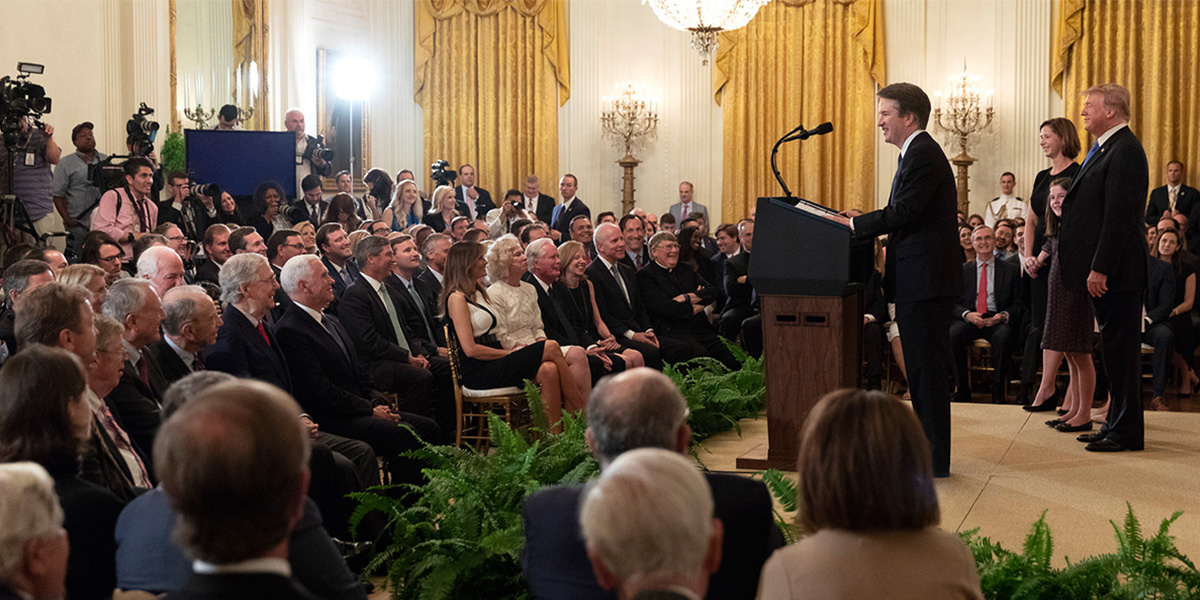
The Environmental Stakes of Brett Kavanaugh’s Supreme Court Nomination

When President Donald Trump announced Brett Kavanaugh as his pick to replace retiring Supreme Court Justice Anthony Kennedy on Monday, he picked the potential justice with the most environmental law experience of his final four frontrunners, E&E reported.
The announcement sent environmentalists and legal experts scouring through his more than 300 rulings on the D.C. Circuit Court to reveal a contradictory picture: Kavanaugh accepts the science behind climate change, but has ruled against the Environmental Protection Agency’s (EPA) attempts to do anything about it.
“Judge Kavanaugh isn’t anti-environmental, but he tends to be anti-agency,” Michael Gerrard told Inside Climate News. Gerrard is the director of the Sabin Center for Climate Change Law at Columbia University. “He’s often struck down regulation that he didn’t think Congress had authorized explicitly enough.”
In a 2012 case, for example, he dissented from a majority ruling upholding Obama-era attempts to limit greenhouse gas emissions, arguing Congress had not empowered the EPA to do so.
“The task of dealing with global warming is urgent and important,” he wrote, according to The New York Times. But, despite that, he ruled the “EPA went well beyond what Congress authorized.”
Kavanaugh’s past rulings are particularly important because, if confirmed, he could have a major impact on the Supreme Court’s environmental decisions. This is because Kennedy was a key swing vote on the issue.
In Massachusetts v. EPA, Kennedy broke a tie in ruling that the EPA could regulate greenhouse gases under the Clean Air Act, even though the act does not mention them explicitly, since it was written in the 1970s, before climate change was a major concern.
Kavanaugh’s strict adherence to the letter of Congressional laws suggests to legal scholars he would have ruled differently.
“I think he would have decided against Massachusetts v. EPA,” University of California Los Angeles environmental law professor Ann Carlson told The Atlantic. “Everything points to the direction of a very narrow construction of the Clean Air Act, and that will seriously limit the EPA’s authority to regulate greenhouse gases in a way that makes a meaningful difference.”
Kavanaugh decided against the EPA in three major cases involving the Clean Air Act during the Obama years, The Atlantic reported.
In one, E.M.E. Homer City Generation v. Environmental Protection Agency, he struck down the EPA’s ability to regulate air pollution that passed from one state to another. The Supreme Court later overturned that decision, in a ruling Kennedy supported, according to The New York Times.
Kavanaugh has ruled in favor of environmental actions in some instances, however. In 2013, he ruled that it was legal for the EPA to revoke a mountaintop-removing mining permit in West Virginia, though he ruled against the EPA in a different legal argument involving the same case, according to The Atlantic.
In 2014, he also decided in favor of the Natural Resources Defense Council in a case challenging pro-industry policies for emissions from cement kilns, The New York Times reported.
Harvard law professor Richard J. Lazarus told The New York Times that Kavanaugh was not hostile to environmental laws per se, but that his approach might harm the environment as long as the legislative branch declines to pass new ones.
“Congress stopped making clean air laws after 1990, so the EPA has to work with increasingly tenuous statutory language. In effect, his approach to environmental law would make it harder to address current problems so long as Congress remains out of the lawmaking business,” Lazarus said.
However, Kavanaugh’s approach could also stymie the Trump EPA’s attempts to deregulate independent of Congress.
“If he faces some Scott Pruitt-era rule that was kind of done quick and dirty, I don’t think the administration should expect him to rubber-stamp it,” Case Western Reserve University law professor Jonathan Adler told The Atlantic. “He doesn’t grade federal agencies on a curve.”

 233k
233k  41k
41k  Subscribe
Subscribe 